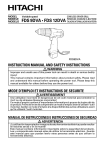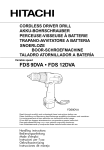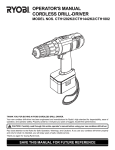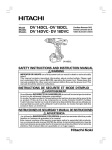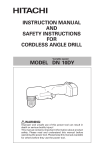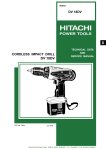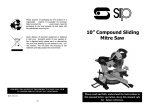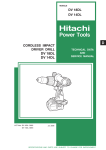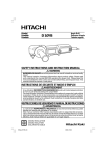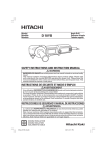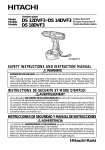Download Ryobi CTH1202K2 Technical data
Transcript
MODEL FDS 12DVA POWER TOOLS CORDLESS DRIVER DRILL FDS 12DVA LIST No. F835 TECHNICAL DATA AND SERVICE MANUAL Nov. 1999 SPECIFICATIONS AND PARTS ARE SUBJECT TO CHANGE FOR IMPROVEMENT F REMARK: Throughout this TECHNICAL DATA AND SERVICE MANUAL, a symbol(s) is(are) used in the place of company name(s) and model name(s) of our competitor(s). The symbol(s) utilized here is(are) as follows: Competitors Symbols Utilized Company Name Model Name B BOSCH PSR12VES-2 J RYOBI CTH1202K2 Notice for use Specifications and parts are subject to change for improvement. Refer to Hitachi Power Tool Technical News for further information. CONTENTS Page [ Business Section ] 1. PRODUCT NAME • • • • • • • • • • • • • • • • • • • • • • • • • • • • • • • • • • • • • • • • • • • • • • • • • • • • • • • • • • • • • • • • • • • • • • • • • • • • • • • • • • • • • • • • • • • • • • • • • • • • • • • • • • • • • • • • • • • • • • • • • • • • • • • • • • • • • • • • • • • • • • • • • • • • • • • • • • • • • • • • • • • • • • • • • • • • • • • • • • • • • • • • • • • • • • • • • • • • • • • • • • • • • • • • • • • • • • • • • • • • • • • • • • 1 • • • • • • • • • • • • • • • • • • • • • • • • • • • • • • • • • • • • • • • • • • • • • • • • • • • • • • • • • • • • • • • • • • • • • • • • • • • • • • • • • • • • • • • • • • • • • • • • • • • • • • • • • • • • • • • • • • • • • • • • • • 1 2. MARKETING OBJECTIVE 3. APPLICATIONS 1 4. SELLING POINTS • • • • • • • • • • • • • • • • • • • • • • • • • • • • • • • • • • • • • • • • • • • • • • • • • • • • • • • • • • • • • • • • • • • • • • • • • • • • • • • • • • • • • • • • • • • • • • • • • • • • • • • • • • • • • • • • • • • • • • 4-1. Selling Point Descriptions 5. SPECIFICATIONS 1 ••••••••••••••••••••••••••••••••••••••••••••••••••••••••••••••••••••••••••••••••••••••••••••••••••••••• 2 • • • • • • • • • • • • • • • • • • • • • • • • • • • • • • • • • • • • • • • • • • • • • • • • • • • • • • • • • • • • • • • • • • • • • • • • • • • • • • • • • • • • • • • • • • • • • • • • • • • • • • • • • • • • • • • • • • • • • • • 3 6. COMPARISONS WITH SIMILAR PRODUCTS • • • • • • • • • • • • • • • • • • • • • • • • • • • • • • • • • • • • • • • • • • • • • • • • • • • • • • • • • • • • • • • • • • • • • • • • • • • • 7. WORKING PERFORMANCE PER SINGLE CHARGE •••••••••••••••••••••••••••••••••••••••••••••••••••••••••••••••• 5 • • • • • • • • • • • • • • • • • • • • • • • • • • • • • • • • • • • • • • • • • • • • • • • • • • • • • • • • • • • • • • • • • • • • • • • • • • • • • • • • • • 6 • • • • • • • • • • • • • • • • • • • • • • • • • • • • • • • • • • • • • • • • • • • • • • • • • • • • • • • • • • • • • • • • • • • • • • • • • • • • • • • • • • • • • • • • • • • • • • • • • • • • • • • • • • • • • • • • • 6 8. PRECAUTIONS IN SALES PROMOTION 8-1. Safety Instructions 4 8-2. Inherent Drawbacks of Cordless Driver Drills Requiring Particular Attention During Sales Promotion •••••••••••••••••••••••••••••••••••••••••••••••••••••••••••••••••••••••••••••••••••••••••••••••••••••••••••••••••••• 9. REFERENCE MATERIALS • • • • • • • • • • • • • • • • • • • • • • • • • • • • • • • • • • • • • • • • • • • • • • • • • • • • • • • • • • • • • • • • • • • • • • • • • • • • • • • • • • • • • • • • • • • • • • • • • • • • • • • • • 9-1. Speed Control Mechanism 8 9 • • • • • • • • • • • • • • • • • • • • • • • • • • • • • • • • • • • • • • • • • • • • • • • • • • • • • • • • • • • • • • • • • • • • • • • • • • • • • • • • • • • • • • • • • • • • • • • • • • • • • 9 • • • • • • • • • • • • • • • • • • • • • • • • • • • • • • • • • • • • • • • • • • • • • • • • • • • • • • • • • • • • • • • • • • • • • • • • • • • • • • • • • • • • • • • • • • • • • • • • • • • • • • • • • • • • • • • • • • • • • • • • • 10 [ Service Section ] 10. REPAIR GUIDE 10-1. Precautions in Disassembly and Reassembly • • • • • • • • • • • • • • • • • • • • • • • • • • • • • • • • • • • • • • • • • • • • • • • • • • • • • • • • • • • • • • • • • • • • • • • • • • • • • • • • • • • • • • • • • • • • • • • • • • • • • • • • • • • • • • • • • • • • 16 • • • • • • • • • • • • • • • • • • • • • • • • • • • • • • • • • • • • • • • • • • • • • • • • • • • • • • • • • • • • • • • • • • • • • • 17 10-2. Precautions in Disassembly and Reassembly of Battery Charger 11. STANDARD REPAIR TIME (UNIT) SCHEDULES 10 [ Appendix ] Assembly Diagram for FDS 12DVA ••••••••••••••••••••••••••••••••••••••••••••••••••••••••••••••••••••••••••••••••••••••••••••••••• 18 1. PRODUCT NAME Hitachi 12 V Cordless Driver Drill, Model FDS 12DVA 2. MARKETING OBJECTIVE Since the sales initiation of economically priced cordless driver drills FDS series, they have been well received over a period of 4 years in international markets. As a result of innovative technical research and development program for operability, overload durability and market price competitiveness, the Model FDS 12DVA has been developed to enhance the market share of Hitachi Cordless Power Tools. Vigorous sales promotion is anticipated with concurrent introduction of new Model FDS 9DVA. 3. APPLICATIONS Tightening and loosening wood screws, self-tapping screws and machine screws Drilling into wood materials, plastic, mild steel and aluminum 4. SELLING POINTS 22-position adjustable torque setting Two speed transmission with one-touch speed shift knob Variable torque setting for fastener tightening Motor with cooling fan 10 mm keyless chuck Variable speed switch with braking function Push-button type reversing switch Equipped with feedback power control 1.4 Ah cassette battery --- 1 --- 4-1. Selling Point Descriptions 4-1-1. 22-Position Adjustable Torque Setting The number of clutch positions has been increased from the previous five to twenty-two to ensure finer torque setting than that of previous model, and therefore, the operability has been significantly improved. (See Fig. 1.) Torque (N•m) (kgf•cm) 5.9 60 5.4 55 4.9 50 4.4 45 3.9 40 3.4 35 2.9 30 2.5 25 2.0 20 1.5 15 1.0 10 Clutch position Adjustable torque is about 2 kgf•cm at each click within the torque range of 10 --- 60 kgf•cm. 1 • 3 • 5 • 7 • 9 • 11 • 13 • 15 • 17 • 19 • • 22 Fig. 1 Clutch torque 4-1-2. Motor with Cooling Fan The cooling fan incorporated in the motor and the air vents provided in its outer frame greatly enhance the cooling effect, ensuring improved durability in continuous operation. 4-1-3. 10 mm Keyless Chuck The keyless chuck facilitates fast and easy replacement of driver bits. Replacement can be carried out simply by holding the ring with one hand, while turning the sleeve with the other hand. Tighten Driver bit Loosen Ring Sleeve Fig. 2 4-1-4. Variable Speed Switch with Braking Function The braking function allows the driver unit to stop rotation immediately when the trigger switch is released, which is a convenient feature during actual working. Also, the feedback system ensures a sufficiently large torque even in the variable speed range. --- 2 --- 5. SPECIFICATIONS Capacity Screwdriver Machine screw 6 mm (1/4") 5.5 x 63 mm (#12 x 2-1/2") Wood screw Drill Metal Mild steel 12 mm (15/32") [thickness 1.6 mm (1/16")] Aluminum 15 mm (19/32") [thickness 1.6 mm (1/16")] Wood 21 mm (13/16") [thickness 18 mm (11/16")] • • • • • • • • • • • • • • • • • • • • • • • • • • • • • • • • • • • • • • • • • • • • • • • • Keyless chuck (10TLRE-N) Mount type Diameter Rotation speed 0 --- 350 /min, 0 --- 1,050 /min Type of motor DC magnet motor Torque Slip torque Max. torque Screw-on (UNF 3/8" --- 24") 0.8 --- 10 mm (1/32" --- 3/8") • • • • • • • • ••••••• 1.0 --- 5.9 N•m, 10 --- 60 kgf•cm (9 --- 52 in-lbs.) [22 stages] Low 21.6 N•m, 220 kgf•cm (191 in-lbs.) High 6.9 N•m, 70 kgf•cm (61 in-lbs.) Type of switch Trigger switch with push button for forward and reverse rotation changeover (w/o stopper) Type of handle T-type Enclosure Body Battery Charger • • • • • • • • • • • • • • • • • • • • • • • • • • • • • • • • • • • • • • • • • Battery (Type FEB 12S) • • • • • • • • • • • • • • • • • • Glassfiber reinforced polycarbonate resin (moss green) ABS resin (black) ABS resin (black) Sealed cylindrical nickel cadmium storage battery Nominal voltage DC 12 V Nominal life Charging/discharging: approximately 500 times Capacity 1.4 Ah Charging time 60 minutes (with standard accessory charger at ambient temperature of 20 ˚C) Charging temperature 10 ˚C --- 40 ˚C (50 ˚F --- 104 ˚F) • • • • • • • • • • • • • • • • • • • • • • • • • • • • • • • • • • • • • • • • • • • • • • • • • • • • • • • • • • • • • • • • • • • • • • • • • • • • • • • • • • • • • • • Charger (Model UC 12SD) Overcharge prevention circuit: A thermostat monitors the surface temperature of the battery and, on detecting the temperature rise which occurs on completion of charging, automatically turns off the unit to prevent the battery from overcharge. Input capacity: 51 W Indication method: Pilot lamp indicator of battery charging Function: On During charging Off Charging completed • • • • • • • • • • • • • • • • • • • • • • • • • • • • • • • • • • • • • • • • • • Weight Main body unit Charger unit Gross with charger and case • • • • • • • • • • • • • • • • • • • • • • • • • • • • • • • • • • • • • • • • • • • • • • • • • • • • • • • • • • • • • • • • • • • • • • • • • • • • • Standard accessories 1.6 kg (3.4 Ibs.) 1.4 kg (3.1 Ibs.) 5.0 kg (11.0 Ibs.) • • • • • • • • • • • • • • • • • • • • • • • • • • • • • • • • • • • • • • • • • • • • • • • • • • • • • • • • • • • • • • • • • • • • • • • • • • • • • • • • • • • • • • • • • • • • • • • • • • • • • • • • • • • • • • • • • • • • • • • • • • • • • • • Charger (UC 12SD) Phillips (plus) driver bit (No.2) Case • • • • • • • • • • • • • • • • • • • • • • • • • • • • • • • • • • • • • • • • • • • • • • • • • • • • • • • • • • • • • • • • • • • • • • • • • • • • • • • • • • • • • • • • • • • • • • • • • • • • • • • • • • • • • • • • • • • • • • • • • • • • • • • • • • • • • • • • • • • • • • • • • • • • • • • • • • • • • • • • • • • • • • • • • • • • • • • • • • • • • • • • • • • • • • • • • • • • • • • • • • • • • • • • • • • • • • • • • • • • • • • • • • • • • • • • • • • • • • • • • • • • • • • • • • • • • • • • • • • • • • • • • • • • • • • • --- 3 --- 1 1 1 6. COMPARISONS WITH SIMILAR PRODUCTS Catalog specifications Maker HITACHI HITACHI Model FDS 12DVA FDS 12DV 6 mm (1/4") 6 mm (1/4") Max. capacity Machine screw Screw driving Drilling Rotation speed Wood screw J 8 mm (5/16") Not indicated Not indicated Not indicated Mild steel 12 mm (15/32") 10 mm (3/8") 12 mm (15/32") Not indicated Aluminum 15 mm (19/32") 10 mm (3/8") 15 mm (19/32") Not indicated Wood 21 mm (13/16") 18 mm (23/32") 20 mm (25/32") Not indicated Low 0 --- 350 /min 0 --- 290 /min 0 --- 400 /min 0 --- 300 /min High 0 --- 1,050 /min 0 --- 900 /min 0 --- 1,150 /min 0 --- 1,000 /min Keyless Keyless Keyless Keyless 10 mm (3/8") 10 mm (3/8") 10 mm (3/8") 10 mm (3/8") DC magnet motor DC magnet motor DC magnet motor DC magnet motor Type Drill chuck 5.5 mm dia. x 63 mm length 5.5 mm dia. x 63 mm length (#12 x 2-1/2) (#12 x 2-1/2") B Capacity Motor 2-Speed transmission Electric brake Gear changeover type 2-speed transmission Equipped Equipped Equipped Equipped 1.0 --- 5.9 N•m 10 --- 60 kgf•cm (9 --- 52 in-lbs.) [22 positions] 1.0 --- 4.9 N•m 10 --- 50 kgf•cm (9 --- 43 in-lbs.) [5 positions] 1.0 --- 8.0 N•m 10 --- 82 kgf•cm (9 --- 71 in-lbs.) [5 positions] Not indicated [23 positions] Low 21.6 N•m 220 kgf•cm (191 in-lbs.) 17.6 N•m 180 kgf•cm (156 in-lbs.) 16.0 N•m 163 kgf•cm (142 in-lbs.) Not indicated High 6.9 N•m 70 kgf•cm (61 in-lbs.) 5.9 N•m 60 kgf•cm (52 in-lbs.) Not indicated Not indicated Nominal capacity 1.4 Ah 1.3 Ah 1.4 Ah 1.3 Ah Nominal voltage 12 V 12 V 12 V 12 V Charging time* 60 minutes 60 minutes 60 minutes 60 minutes Battery mount Cassette type Cassette type Cassette type Cassette type Overall length 220 mm (8-21/32") 223 mm (8-25/32") 219 mm (8-5/8") 250 mm (9-27/32") Weight 1.6 kg (3.4 lbs.) 1.6 kg (3.5 lbs.) 1.6 kg (3.5 lbs.) 1.6 kg (3.5 lbs.) Slip torque Battery Max. torque Remarks* • • • • • • • • Charging time varies depending on the type of charger to be used. --- 4 --- 7. WORKING PERFORMANCE PER SINGLE CHARGE Drilling and fastening performance comparison per charge Working capacity (*1) Type of work Mild steel Maker T1.6 (1/16") Model name *0 0 *250 50 6.5 mm dia. (1/4") American pine FDS 12DV 60 10.3 40 6.9 55 8.5 FDS 12DVA 205 18 mm dia. (11/16") HITACHI 215 FDS 12DV 140 B Wood boring <Low speed> 4.7 FDS 12DV 85 5.9 45 B 4.6 70 J FDS 12DVA 12 mm (15/32") 4.3 85 6.0 <Low speed> Machine screw 6 mm (1/4") 4.4 FDS 12DVA HITACHI Wood screw 3.5 3.1 195 J 63 mm (2-1/2") 5.5 mm dia. (#12) American pine Driling speed (sec./pc.) 9.3 J T18 (11/16") *1000 200 55 B <High speed> *750 150 FDS 12DVA HITACHI HSS drill bit *500 100 HITACHI FDS 12DV *850 *895 *650 B *745 J <High speed> 0.9 1.0 0.8 0.9 Remarks* Number of machine screws fastened per charge Remarks*1 Number of holes or fasteners per charge The above table shows an example of test data obtained using the battery which is standard for this tool. As actually measured values listed in the above table may vary depending on the sharpness of the drill bit, workpiece hardness (particularly in wood materials), moisture content of wood, charging condition, operator skill, etc. This data should be used as a comparative guide only. --- 5 --- 8. PRECAUTIONS IN SALES PROMOTION 8-1. Safety Instructions In the interest of promoting the safest and most efficient use of the Model FDS 12DVA Cordless Driver Drill by all of our customers, it is very important that at the time of sale, the salesperson carefully ensures that the buyer seriously recognizes the importance of the contents of the Handling Instructions, and fully understands the meaning of the precautions listed on the Caution Plate and Name Plate attached to each tool. A. Handling Instructions Salespersons must be thoroughly familiar with the contents of the Handling Instructions in order to give pertinent advice to the customer. In particular, they must have a thorough understanding of the precautions for use of the cordless tools which are different from those of ordinary electric power tools. (1) Before use, ensure that the unit is fully charged. New units are not fully charged. Even if the units were fully charged at the factory, long periods of inactivity, such as during shipping, cause the storage battery to lose its charge. Customers must be instructed to fully charge the unit prior to use. (2) When charging storage batteries, use only the exclusive Model UC 12SD Charger provided with the tool. Because of the designed rapid-charging feature (about one hour), use of other battery chargers is hazardous. (3) Connect the Charger to an AC power outlet only. Use of any other power source (DC outlet, fuel powered generator, etc.) will cause the Charger to overheat and burn out. (4) Do not use any voltage increasing equipment (transformer, etc.) between the power source and the Charger. If the Charger is used with voltage higher than that indicated on the unit, it will not function properly. (5) Conduct battery charging at an ambient temperature range of 10 ˚C --- 40 ˚C (50 ˚F --- 104 ˚F). Special temperature sensitive devices are employed in the Charger to permit rapid charging. Ensure that customers are instructed to use the Charger at the indicated ambient temperature range. At temperature under 10 ˚C (50 ˚F) the thermostat will not function properly, and the storage battery may be overcharged. At temperature over 40 ˚C (104 ˚F), the storage battery cannot be sufficiently charged. The optimum temperature range is 20 ˚C --- 25 ˚C (68 ˚F --- 77 ˚F). (6) The battery charger should not be used continuously. At high ambient temperature, if over three storage batteries are charged in succession, the temperature of the coils on the transformer will rise and there is a chance that the temperature fuse inserted in the interior of the transformer will inadvertently melt. After charging one battery, please wait about 15 minutes before charging the next battery. (7) Do not insert foreign objects into the air vents on the Charger The Charger case is equipped with air vents to protect the internal electronic components from overheating. Caution the customer not to allow foreign materials, such as metallic or flammable objects, to be dropped or inserted into the air vents. This could cause electrical shock, fire, or other serious hazards. --- 6 --- (8) Do not attempt to disassemble the Storage Battery or the Charger. Special devices, such as a thermostat, are built into the storage battery and charger to permit rapid charging. Incorrect parts replacement and/or wiring will cause malfunctions which could result in fire or other hazards. Instruct the customer to bring these units to an authorized service center in the event repair or replacement is necessary. (9) Disposal of the Type FEB 12S Storage Battery Ensure that all customers understand that Type FEB 12S Storage Batteries should be turned in to any Hitachi Power Tools sales outlet or authorized service center when they are no longer capable of being recharged or repaired. If thrown into a fire, the batteries may explode, or, if discharged indiscriminately, leakage of the cadmium compound contained in the battery may cause environmental pollution. B. Caution Plates (1) The following cautions are listed on the Name Plate attached to the main body of each tool. Be particularly careful to ensure that the customer understands the necessity of removing the storage batteries prior to bit replacement, cleaning, inspection or carrying of the tool when not in use. For Europe CAUTION Read thoroughly HANDLING INSTRUCTIONS before use. For Germany, Switzerland, Austria, and Belgium ACHTUNG Lesen Sie die Bedienungsanleitung sorgfältig. For France CAUTION TRES IMPORTANT : Lire avec attention la notice d'utilisation. For Italy ATTENZIONE Leggere attentamente le istruzioni prima dell' uso. (2) The following cautions are listed on the Name Plate attached to each Type FEB 12S Storage Battery. CAUTION Read thoroughly HANDLING INSTRUCTIONS before use. Do not disassemble nor throw into fire. --- 7 --- 8-2. Inherent Drawbacks of Cordless Driver Drills Requiring Particular Attention During Sales Promotion The cordless driver drill offers many advantages; it can be used in places where no power source is available, the absence of a cord allows easy use, etc. However, any cordless tool has certain inherent drawbacks. Salespersons must be thoroughly familiar with these drawbacks in order to properly advise the customer in the most efficient use of the tool. A. Suggestions and precautions for the efficient use of the tool (1) Use the Cordless Driver Drill for comparatively light work. Because they are battery driven, the output of the motor in cordless driver drills is rather low in comparison with conventional electric power tools. Accordingly, they are not suitable for continuous drilling of many holes in succession, or for drilling into particularly hard materials which creates a heavy load. Salespersons should recommend conventional electric power tools for such heavy work. (2) Drilling of large diameter holes should be conducted at low speed. Instruct the customer that drilling of large diameter holes or other work which requires particularly strong torque should be done at low speed. Because there is less torque at high speed, attempting such work at high speed will not improve working efficiency. (3) Do not insert a foreign object into body vent holes. The body of this tool has vent holes for improving the cooling efficiency. As a fan is built into the motor, a foreign object inserted through a vent hole may cause a failure. Please instruct customers to never insert a foreign object into the vent hole. (4) Avoid "Locking" of the motor. Locking of the motor will cause an overload current that could result in burning of the motor and/or rapid deterioration of the battery. Salespersons should advise the customer to immediately release the switch and stop operation if the motor becomes locked. (A jammed drill bit can be disengaged from the workpiece material by setting the switch to reverse rotation, or by manually turning the main body of the tool.) (5) Variation in amount of work possible per charge Although the nominal chargeable capacity of the storage batteries used with the Model FDS 12DVA is 1.4 Ah, the actual capacity may vary within 10% of that value depending on the ambient temperature during use and charging, and the number of times the batteries have been recharged. It should be noted that other factors which may have a bearing on the amount of work possible per charge are the working conditions (ambient temperature, type and moisture content of the workpiece, sharpness of the drill bit, etc.) and the operational skill of the user. --- 8 --- (6) Precautions in the use of HSS Drill Bits Although the Model FDS 12DVA is designed for drilling capacities of 21 mm (13/16") in wood, and 15 mm (19/32") in aluminum, and 12 mm (15/32") in mild steel, this capability is not as efficient as conventional electric power tools. In particular, when drilling through aluminum material with a 15 mm (19/32") drill bit, the drill tends to become locked when the drill bit penetrates through the material. For this reason, the customer should be cautioned to reduce the thrust on the main body of the drill when drilling completely through the material to avoid locking the tool. Repeated locking of the drill causes excessive current flow from the batteries which not only decreases the amount of work possible per charge, but could also result in burning of the motor. B. Suggestions and precautions for the efficient use of the charger and storage batteries If the Type FEB 12S Storage Batteries are exposed to direct sunlight for an extended period or if the tool has just been operated for a long time, charging may not be possible if the temperature of a battery (type FEB 12S) is above 40 ˚C (104 ˚F). In such a case, the customer should be advised to place the battery in a shaded area with a good airflow, and allows sufficient cooling before recharging. This phenomenon is common to all existing batteries and chargers which employ temperature sensitive overcharge protection devices. The cooling time required before recharging can be accomplished varies from a few minutes to about 30 minutes, depending on the load, duration of use, and ambient temperature. 9. REFERENCE MATERIALS 9-1. Speed Control Mechanism Spindle rotation speed of the Model FDS 12DVA can be (%) 100 trigger switch is depressed. The relationship between the amount the trigger switch is depressed (in millimeters) and the rotation speed is illustrated in Fig. 3. Note: The gradient and values illustrated in Fig. 3 are intended for reference only, and will vary slightly due to differences in the discharge condition of the battery, the ambient temperature, and individual speed-control element accuracy. Rotation speed controlled by simply varying the amount by which the 60 5 12 8 0 8 +0.5 0 2.2 0.5 6.5 0.5 Amount trigger switch is depressed (mm) Fig. 3 --- 9 --- 10. REPAIR GUIDE Be sure to remove the storage batteries from the main body before servicing. Inadvertent triggering of the switch with the storage battery connected will result in the danger of accidental turning of the motor. 10-1. Precautions in Disassembly and Reassembly The [Bold] numbers in the description below correspond to the item numbers in the Parts List and exploded assembly diagram for the Model FDS 12DVA. 10-1-1. Disassembly (1) Removal of Housing (B) [31] Remove the seven Tapping Screws (W/Washers) D3 x 16 [26] secured to the main body. Gently open Housing (A) [31] and Housing (B) [31] while holding their battery loading sections. (2) After Housing (B) [31] has been removed, all the internal parts, assembled or separate, can be taken out as they are. Lift the entire contents from Housing (A) [31] while holding the Motor [25] and Cap [4]. (3) Removal of the Drill Chuck [2] (See Fig. 4.) (a) Turn the Motor [25] counterclockwise (when viewed from the rear) and remove it from the Rear Case [14]. Remove the Shift Knob [37] from the Shift Arm [16]. Take care not to remove the Shift Arm [16] from the Rear Case [14] in this operation. (b) Attach the motor spacer (an accessory of the special repair tool J-292, Code No. 316379) to the assembly of the Drill Chuck [2], Cap [4], Front Case [9] and Rear Case [14] and then mount it in special repair tool J-292 clamped in the vise as illustrated in Fig. 4. In this operation, check that the pinion press-fitted in the special repair tool J-292 and Planet Gear (A) [21] are engaged properly. (c) Turn the Cap [4] clockwise (when viewed from the front) until it can turn no further. In this position, the drill mark " " on the Cap [4] is positioned on the Shift Arm [16] side. Secure the Slide Ring Gear [17] to the Front Case [9] side with the Shift Arm [16]. (d) Turn the sleeve of the Drill Chuck [2] counterclockwise (when viewed from the front) to fully open the jaws of the Drill Chuck [2]. Turn the Special Screw (Left Hand) M5 x 35 [1] clockwise and remove it. (Note that the Special Screw is left-hand threaded.) (e) Fit the hexagonal bar wrench M10 into the Drill Chuck [2] as illustrated in Fig. 4 and remove the Drill Chuck [2] by turning the hexagonal bar wrench counterclockwise. --- 10 --- Drill Chuck [2] Special Screw M5 x 35 [1] Hexagonal bar wrench Cap [4] Front Case [9] Slide Ring Gear [17] Shift Arm [16] Rear Case [14] Vise Special repair tool (J-292) Fig. 4 (4) Disassembly of the gear unit Remove the Shift Arm [16] from the Rear Case [14], then remove the four Screws Set D3 x 12 [15] connecting the Front Case [9] and the Rear Case [14]. Remove Washer (A) [13], Planet Gears (C) Set [12], Ring Gear [11] and the twelve Steel Balls D5 [10] from the Front Case [9] in order. Take care not to lose the twelve Steel Balls D5 [10] in this operation. (5) Removal of the Spring [6] and Washer (D) [7] Turn the Nut [5] counterclockwise and remove it from the Front Case [9], then remove the Spring [6] and Washer (D) [7] from the Front Case [9]. (Note) Do not remove the Front Case [9]. (6) Disassembly of the power supply unit (Note) Do not remove the fin secured to the DC-Speed Control Switch [34] with a screw. Remove the two Machine Screws M3 x 8 [29], and take the Motor [25] and the Motor Spacer [24] apart. Disconnect the Internal Wires (B) [32] [33] from the Motor [25] with a soldering iron, then disconnect them from the DC-Speed Control Switch [34] with a soldering iron in the same manner. 10-1-2. Reassembly Reassembly can generally be carried out as the reverse of the disassembly procedure, with some items to be noted as follows. (2) Reassembly of the power supply unit (a) Be sure to perform wiring connections as indicated in the wiring diagram. (See Fig. 5.) --- 11 --- Motor [25] Motor Spacer [24] Internal Wire (Red) [33] Internal Wire (Black) [32] Machine Screw M3 x 8 [29] Ferrite Core [35] Spring Washer M3 [30] DC-Speed Control Switch [34] Internal Wire (Red) [33] Internal Wire (Black) [32] Terminal Support (A) [40] Fig. 5 Positive side Red mark (b) Pay attention to the polarity of the Motor [25] when soldering Internal Wires (B) [32] and [33] to the Motor [25]. The red-marked side of the Motor [25] is positive. (See Fig. 6.) (c) Apply grease (Hitachi Motor Grease No. 29, Code No. 930035 is recommended) to the pinion press-fitted on the Motor [25] shaft. Negative side Fig. 6 (2) Reassembly of the clutch unit (a) Mount Washer (D) [7] and the Spring [6] to the Front Case [9]. (See Fig. 7.) When mounting Washer (D) [7] into the Front Case [9], align the projection on the Front Case [9] with the notch of Washer (D) [7]. Register mark (oo) Nut [5] Washer (D) [7] Spring [6] Projection Notch Z surface Z surface Register mark (o) Register mark Fig. 7 --- 12 --- Front Case [9] (b) Mount the Nut [5] to the Front Case [9]. (See Fig. 8.) Align the register mark (o) on the Nut [5] with the register mark on the Front Case [9]. Turn the Nut [5] about 1 --- 1/4 turns clockwise so that the register mark (oo) on the Nut [5] is aligned with the register mark on the Front Case [9]. Check that the Z surface of the Nut [5] is aligned with the Z surface of the Front Case [9]. Mounting start position Mounting end position Register mark (o) Register mark (oo) Register mark Register mark Register mark (oo) Register mark (o) Z surface of Nut [5] Z surface of Front Case [9] Z surface [5] Z surface [5] [9] [9] Fig. 8 (3) Reassembly of the gear unit (a) Apply grease (Hitachi Motor Grease No. 29, Code No. 930035) to the meshing parts of the gear. (b) Install the parts series from the twelve Steel Balls D5 [10] to Washer (B) [23] into the assembly reassembled in step (2). (See Fig. 9.) (i) Note the direction of the groove when installing the Slide Ring Gear [17] so that the groove faces toward the Motor [25]. (ii) Install the Front Case [9] and the Rear Case [14] together with the mark on the Front Case [9] aligned with the mark on the Rear Case [14]. (See Fig. 12.) [9] [10] [11] [17] [18] [19] [12] [20] [13] [21] Groove Fig. 9 --- 13 --- [14] [22] [23] [15] (iii) Install Washer (B) [23] in the Rear Case [14] with the projections of Washer (B) [23] engaged with the recesses in the Rear Case [14], and turn Washer (B) [23] clockwise until it can turn no further. (See Fig. 10.) Recess Projection [23] Projection Fig. 10 (c) Install the Click Spring [8] and the Cap [4] on the assembly reassembled in step (b). (See Fig. 11.) (i) Insert the projection of the Click Spring [8] into the hole of the Front Case [9]. (ii) Mount the Cap [4]. Mount the Nut [5] into the Cap [4] engaging the wider projection of the Nut [5] with the wider recess of the Cap [4]. (The wider recess of the Cap [4] is positioned at "1" when viewed from the outside.) (iii) Apply grease (Hitachi Motor Grease No. 29, Code No. 930035) to the sliding surfaces of the Cap [4] and the Click Spring [8]. Cap [4] "1" Wider recess Wider projection Click Spring [8] Nut Projection Hole Cap [4] Recesses Nut [5] Projections Fig. 11 (d) Install the Shift Arm [16] into the assembly reassembled in step (c). With the ridge at the Shift Arm [16] facing the Motor [25] side, first install them on the unmarked side of the assembly reassembled in step (c). Then insert the projections on the Shift Arm [16] into the holes in the Rear Case [14] and make sure that the projections are fitted into the grooves in the Slide Ring Gear [17] mounted within the Rear Case [14]. (See Fig. 12.) --- 14 --- Ridge [16] [16] Hole Mark Groove Fig. 12 (e) Install the Drill Chuck [2]. Install the Drill Chuck [2] using the special repair tool (J-292, Code No. 316379) and secure it with the Special Screw (Left Hand) M5 x 35 [1]. (f) Install the Shift Knob [37] into the assembly reassembled in step (e). When installing the Shift Knob [37] into the Shift Arm [16], note that the "LOW" mark on the Shift Knob [37] faces the Motor [25] with the Shift Arm [16] engaged with the recess in the Shift Knob [37]. (g) Install the assembly reassembled in step (1) and the assembly reassembled in step (f) together. (See Fig. 13.) Fit the projection on the Motor Spacer [24] into the recess in the Rear Case [14] while ensuring that the Shift Knob [37] is aligned with the positive side of the Motor [25] and turn the Motor Spacer [24] clockwise when viewed from the rear of the Motor [25] until it can turn no further. During installation, make sure that the pinion press-fitted onto the shaft of the Motor [25] and Planet Gear (A) [21] mesh properly. Projection Recess Fig. 13 (4) Installation of the Bit Holder [28] into Housing (B) [31] Fit the upper and lower projections of the Bit Holder [28] in the grooves in Housing (B) [31]. (5) Installation of the assembly reassembled in step (3) into Housings (A) and (B) [31] (a) Install the Pushing Button [36] into Housing (B) [31]. (See Fig. 14.) (b) Install the assembly reassembled in step (3) into Housing (A) [31]. Note that the projections on the Front Case [9] and the Motor Spacer [24] are engaged in the recesses in Housing (A) [31], and the projection on Housing (A) [31] is engaged in the groove of the Cap [4]. (See Fig. 15.) --- 15 --- [31] [36] [31] Groove Projection Projections Recesses Fig. 14 Fig. 15 (c) Set the assembly reassembled in step (b) to Housing (B) [31] and secure it with the seven Tapping Screws (W/Washers) D3 x 16 [26]. (d) Verify proper operation of the Cap [4]. When the assembly procedure up to step (c) is completed, ensure that the number "1" on the Cap [4] and the drill mark " " are in alignment with the triangle mark on Housings (A) and (B) [31]. If the Cap [4] turnes loosely, correctly re-install the Click Spring [8] as it is improperly installed. If the number "1" on the Cap [4] or the drill mark " " cannot reach the triangle mark on Housings (A) and (B) [31], correctly re- install the Cap [4] referring to step (3) (c), as it is improperly installed. (6) Other precautions in reassembly (a) When the assembly procedure is completed, make sure that the turning direction of the Drill Chuck [2] corresponds to the position of the Pushing Button [36]. When the Pushing Button [36] is pressed from the (R)-marked side, the Drill Chuck [2] should turn clockwise when viewed from the rear (opposite side of the Drill Chuck [2]). Also make sure that the turning speed of the Drill Chuck [2] switches between "HIGH" and "LOW" by switching over the Shift Knob [37]. Make sure that the run-out of the Drill Chuck [2] holding a 9 mm dia. test bar is below 0.8 mm at a distance of 85 mm from the chuck end. (b) The tightening torque of each screw is given below. Special Screw (Left Hand) M5 x 35 [1] : 2.9 --- 3.9 N•m ( 30 --- 40 kgf•cm, 26.1 --- 34.8 in-lbs.) Drill Chuck [2] : 12.7 --- 16.7 N•m (130 --- 170 kgf•cm, 113 --- 148 in-lbs.) Screw Set D3 x 12 [15] : 0.6 --- 1.0 N•m ( 6 --- 10 kgf•cm, 5.2 --- 8.7 in-lbs.) Machine Screw M3 x 8 [29] : 0.6 --- 0.9 N•m ( 6.5 --- 9.5 kgf•cm, 5.6 --- 8.3 in-lbs.) Tapping Screw (W/Washer) D3 x 16 [26] : 1.1 --- 1.9 N•m ( 11 --- 19 kgf•cm, 9.5 --- 16.5 in-lbs.) 10-2. Precautions in Disassembly and Reassembly of Battery Charger Please refer to the Technical Data and Service Manual for precautions in disassembly and reassembly of the Battery Charger UC 12SD. --- 16 --- 11. STANDARD REPAIR TIME (UNIT) SCHEDULES MODEL Variable Fixed 10 20 Work Flow FDS12DVA General Assembly Spring Drill Chuck Housing (A).(B) Set Motor Cap DC-Speed Control Switch Nut Shift Arm Fin (Gear Box Ass'y) Front Case Lock Ring Ring Gear Carrier First Ring Gear Planet Gear (A) Set Pinion (B) Pinion (C) Slide Ring Gear Planet Gear (C) Set Rear Case --- 17 --- 30 40 50 60 Assembly Diagram for FDS 12DVA --- 18 --- FDS 12DVA PARTS ITEM NO. 1 CODE NO. 318-228 SPECIAL SCREW (LEFT HAND) M5X35 NO. USED 1 2 312-516 DRILL CHUCK 10TLRD-N (W/O CHUCK WRENCH) 1 3 318-229 GEAR BOX ASS’Y 1 4 318-233 CAP 1 5 318-232 NUT 1 6 312-709 SPRING 1 7 312-714 WASHER (D) 1 8 312-713 CLICK SPRING 1 9 318-230 FRONT CASE 10 306-936 STEEL BALL D5 11 312-715 RING GEAR 1 12 312-705 PLANET GEAR (C) SET (3 PCS.) 3 13 312-704 WASHER (A) 1 14 312-697 REAR CASE 1 15 315-817 SCREW SET D3X12 (6 PCS.) 4 311-962 SHIFT ARM 1 315-137 SLIDE RING GEAR 1 18 315-805 PINION (C) 1 19 315-816 PLANET GEAR (B) SET (3 PCS.) 3 20 315-804 PINION (B) 1 21 315-815 PLANET GEAR (A) SET (3 PCS.) 3 22 315-136 FIRST RING GEAR 1 23 312-716 WASHER (B) 1 24 318-231 MOTOR SPACER 1 25 318-244 MOTOR 1 26 991-672 TAPPING SCREW (W/WASHER) D3X16 7 NAME PLATE 1 28 318-237 BIT HOLDER 1 29 949-203 MACHINE SCREW M3X8 (10 PCS.) 2 30 949-451 SPRING WASHER M3 (10 PCS.) 2 31 318-243 HOUSING (A).(B) SET 1 32 306-041 INTERNAL WIRE (B) (BLACK) 1 33 306-040 INTERNAL WIRE (B) (RED) 1 34 318-245 DC-SPEED CONTROL SWITCH 1 35 318-247 FERRITE CORE 1 36 318-235 PUSHING BUTTON 1 37 318-234 SHIFT KNOB 1 HITACHI LABEL 1 306-952 STRAP (BLACK) 1 39 INCLUD.4-24 1 17 38 REMARKS 12 16 27 * DESCRIPTION FOR FRG,AUT,ITA,HOL,SUI,FRA,BEL,ESP 40 315-141 TERMINAL SUPPORT (A) 1 * 41 318-241 BATTERY FEB 12S (W/ENGLISH N.P) 1 * 41 318-239 BATTERY FEB 12S (W/ENGLISH N.P) 1 FOR INA,NZL,HKG,SIN,SAF,KOR * 41 318-240 BATTERY FEB 12S (W/ENGLISH N.P) 1 FOR USA,CAN PARTS * : ALTERNATIVE --- 19 --- 9 --- 99 FDS 12DVA STANDARD ACCESSORIES ITEM NO. 501 CODE NO. DESCRIPTION CHARGER (MODEL UC 12SD) NO. USED 1 502 318-236 + DRIVER BIT NO.2 55L 1 * 503 318-246 CASE 1 * 503 318-361 CASE 1 * 504 BIT SET 1 * 505 TORCHLIGHT (MODEL UB 12D) 1 9 --- 99 PARTS * : ALTERNATIVE --- 20 --- REMARKS FOR MODEL WITH TORCHLIGHT























